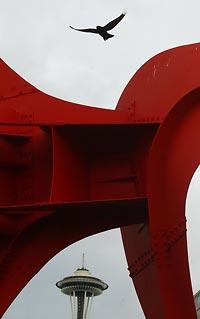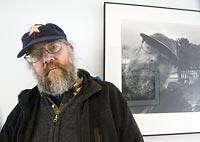|
Friday, June 13, 2008 - Page updated at 11:53 AM Art Review | A critic's-eye view of the new Olympic Sculpture Park
Seattle Art Museum knows how to think big. The institution has raised a record amount of money for a local art institution and presented the city with a remarkable new landmark, the Olympic Sculpture Park, as exciting and audacious as Rem Koolhaas' downtown public library — and with even greater ambitions. At the same time, SAM's busy expanding its downtown venue, set to open in May. But being big isn't enough. The time has come for SAM to act more grown-up, too. The park, which opens Saturday, is a brilliantly crafted place that functions as a vehicle for art as well as offering an exhilarating experience in and of itself. And SAM assembled an enviable selection of top-caliber artists to show there — what institution wouldn't covet Richard Serra's "Wake," Alexander Calder's "Eagle" and a new fountain by Louise Bourgeois? Claes Oldenburg's "Typewriter Eraser," loaned by Paul Allen, has never looked better, ingeniously installed on a slope like some nutty version of a comic-strip roadrunner. Kids love it. I love it. In fact, all the artwork is beautifully sited and the relationships among the pieces were carefully considered. There's enough variety to please a broad swath of people. At the same time, the art selection at the park throws some of the museum's current shortcomings into high relief. In an age when contemporary-art museums are taking a cookie-cutter approach to art — sanctioning an elite group of preapproved artists, often New York-based — Seattle has been more of a follower than a leader. For the past 20 years, SAM has been putting its resources and energy into expansion, hoping that if it provides venues that are big enough and classy enough, important collections of art will come its way. To an extent that has happened, and more major gifts are forthcoming. But it's time for the museum to take the next big step in its evolution and craft a more distinctive identity.
Rethinking regional When the Seattle Art Museum opened in 1933, it was a monument to the collection and the vision of Richard Fuller. Its strength lay in Asian art and grew through an eclectic assortment of work by the Northwest artists Fuller supported and believed in. His commitment to Mark Tobey and Morris Graves led to their discovery by New York curators, bringing them world fame. Why are we still riding on the laurels of Northwest art that was made 50 years ago? Because that's when SAM was actively promoting regional artists. At the same time, the museum mostly ignored the burgeoning contemporary-art scene centered in New York. It was SAM patrons Virginia and Bagley Wright who pushed the institution to join the party. Their passion for blue-chip East Coast art stirred fierce resentment among some local artists and supporters who didn't want their museum geared to outsiders. But the time was right. Coming up Olympic Sculpture Park Opening festivities 10 a.m.-9 p.m. Saturday, 11 a.m.-6 p.m. Sunday, 2901 Western Ave., Seattle, free (206-654-3100 or www.seattleartmuseum.org). For a schedule of events see Friday's Ticket. Winter hours (through April 30): 7 a.m.-6 p.m. daily. For a virtual tour, additional interactive features and a live Webcam, go to www.seattletimes.com/ sculpturepark. As SAM got over its provincialism and opened its eyes to the bigger world of contemporary art, it turned its back on the local scene. Now, it's time for the institution to take the next step in its maturation — and that means once again embracing who we are and what distinguishes the region.
Staying power How can SAM proceed to the next level? A museum's values are set by the board and reflected in the director and curatorial staff. It takes curators with intelligence, audacity, vision and intuition to lead the way. Lisa Corrin, SAM's former deputy director and lead curator, selected the artworks for the park and set its direction. But after just four years at SAM, Corrin quit last year, another quick swoosh through a revolving-door curatorial job. To keep talented people around, SAM needs to be seen as a plum job instead of a step up the ladder. The museum has to spend money on its staff and beef up its meager acquisitions budget, currently around $300,000 a year spread among the departments. (What does that buy? The asking price for Calder's "Eagle," paid for by the Shirleys, was reportedly $10 million to $15 million.) Director Mimi Gates acknowledges that the museum can't keep hoping that "the Mount Rainier factor" is enough to keep top-notch curators and staff happy in Seattle. Even if Corrin had stayed on, she made no secret of the fact that she was not wowed by Washington artists. (She told me in 2003 she was more impressed with Portland's art scene than with Seattle's.) We can be grateful that she approved of Seattle photographer Glenn Rudolph, whose documentation of the waterfront area, beginning in the 1980s, hangs in the park's pavilion and adds a dose of reality to the polish of the place. He found humor and humanity in the street life he photographed; when Corrin commissioned him to continue his series, Rudolph kept the project down-to-earth. Corrin also believed in Roy McMakin, a Seattle resident with a broader following. She commissioned him to create the distinctive multimedia installation "Love & Loss." McMakin delivered a smart and accessible piece, combining interlocking words, a living tree, functional benches and a revolving neon light: a clever metaphor about the way joy and sorrow sprout from a single source, and also a lovely place to sit and ponder the paradox. It's important to note that many of the park's signature artworks were purchased or commissioned especially for it — not just inherited from local collections: "Love & Loss," "Eagle," "Wake," and Bourgeois' fountain "Father and Son" (still under construction at the time of this review). In addition, SAM commissioned Teresita Fernández to make a 200-foot, kaleidoscopically hued bridge canopy (her first permanent outdoor artwork.) On the other hand, the commission that produced Mark Dion's "Neukom Vivarium" was a missed opportunity. Sure, Dion did a project for the opening of the new Museum of Modern Art in New York, but his gee-whiz approach to the Northwest landscape plays out in a piece with fuzzy intentions. The huge nurse log in its greenhouse setting is a natural wonder, hard not to like. But what are we supposed to glean from its presentation? Dion's idea is similar to "Nurse Analog," an outdoor project Seattle artist Buster Simpson did in Portland years ago, but Dion's log requires an expensive incubator and climate control system to keep it growing. To that end, the project (formerly titled "Seattle Vivarium") evoked the worst of the naming-rights frenzy that SAM is promoting to raise cash. It's the first instance I can recall where an artist was asked to change the name of an artwork to honor a donor who helped pay for it.
Controversy Some of the gifts to the park are its weaker links. I'm not convinced Beverly Pepper will stand as a major contributor to 20th-century art. And I'm troubled by SAM accepting the Tony Smith "Stinger," produced under the direction of his estate some 20 years after the artist's death. I admire Smith's work and can easily see the temptation to add a piece to the collection with no expense involved. But it's up to institutions to draw the line at a practice that has unresolved ethical and aesthetic implications. These days, art museums are aiming to be more things to more people, and it comes at a price. SAM is looking at spending $18 million a year to operate its three venues. As the institution tries to balance the needs of its constituencies — donors, board members, local artists and an entertainment-minded public — the choices it makes are only going to get tougher.
Sheila Farr: sfarr@seattletimes.com Copyright © 2007 The Seattle Times Company Most read articles
|
Seattle Times Special
Miracle Machines: The 21st-Century Snake Oil
The Favor Factory
Confronting Malaria
Pike Place Market
Your Courts, Their Secrets
License to Harm
The Bering Sea
Olympic Sculpture Park |












